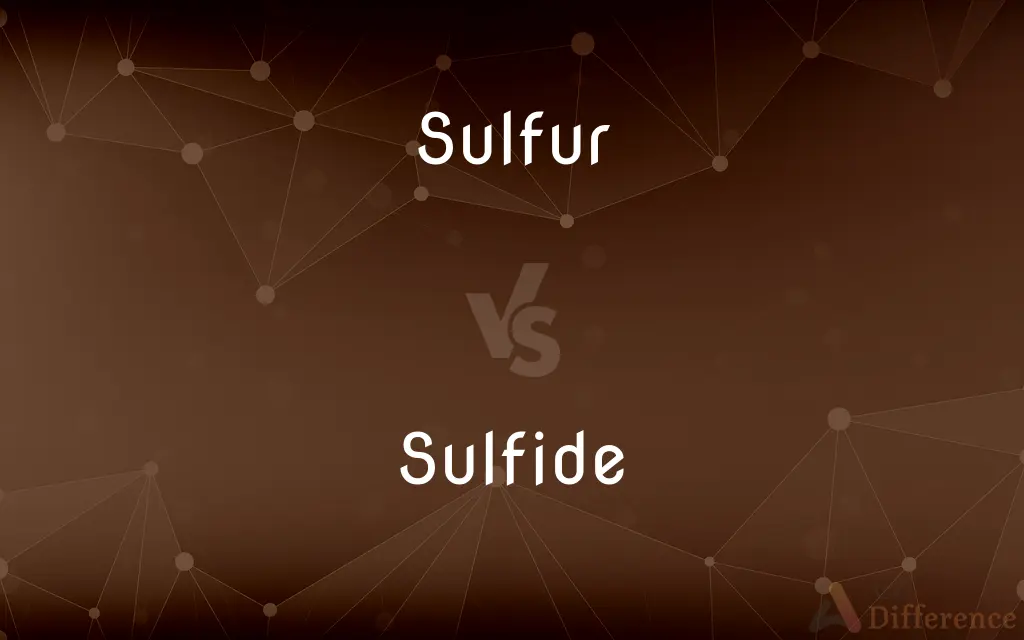Sulfur vs. Sulfide — What's the Difference?
By Fiza Rafique & Maham Liaqat — Updated on March 27, 2024
Sulfur is a chemical element, yellow in color and used in various industries, while sulfide refers to a compound that includes sulfur bonded with a more electropositive element or group.

Difference Between Sulfur and Sulfide
Table of Contents
ADVERTISEMENT
Key Differences
Sulfur, a naturally occurring element represented by the symbol S and atomic number 16, is known for its bright yellow color and distinct odor when burned. It's used in the manufacture of sulfuric acid, fertilizers, and in vulcanizing rubber. Sulfide, on the other hand, is a term for compounds that contain one or more sulfur atoms combined with another element, such as hydrogen sulfide (H₂S) or iron sulfide (FeS), where sulfur acts with a negative charge (S²⁻).
In terms of occurrence, sulfur can be found in its elemental form in nature, often near volcanic regions or hot springs, as well as in various minerals. Sulfides are typically encountered as mineral compounds in the earth's crust. They are important ores from which metals like zinc, lead, and copper are extracted.
From an application perspective, sulfur is widely used in industrial processes, particularly in the production of sulfuric acid, which is a key component in fertilizers, chemicals, and pharmaceuticals. Sulfides play a critical role in metallurgy, serving as the primary source for many metals. Hydrogen sulfide, a specific type of sulfide, is used in the production of sulfur and sulfuric acid but is also notorious for its poisonous properties and rotten egg smell.
Environmentally, sulfur cycles between the atmosphere, terrestrial, and marine ecosystems, playing a crucial role in global climate dynamics and biological systems. Sulfides, especially those in aqueous environments, can contribute to the corrosion of metals and the production of acid mine drainage, posing significant environmental challenges.
Chemically, sulfur exhibits allotropy, existing in several forms, the most common being the orthorhombic crystal form. Sulfides, depending on the metals they are combined with, have various structures and properties, reflecting the diversity of their chemical makeup and uses in different applications.
ADVERTISEMENT
Comparison Chart
Nature
Chemical element (S).
Compound containing sulfur bonded with other elements.
Color
Bright yellow.
Varies depending on the compound.
Occurrence
Elemental form in nature, in minerals.
Mostly in mineral compounds.
Applications
Fertilizers, sulfuric acid, vulcanizing rubber.
Metallurgy, production of metals, sulfuric acid.
Environmental Impact
Participates in global sulfur cycle.
Can cause metal corrosion, acid mine drainage.
Chemical Form
Exists in several allotropes.
Chemical structure varies with the metal or element bonded with sulfur.
Example Compounds
-
Hydrogen sulfide (H₂S), Iron sulfide (FeS).
Compare with Definitions
Sulfur
Participates in the global sulfur cycle.
Sulfur emissions from volcanoes affect climate patterns.
Sulfide
Causes metal corrosion and acid mine drainage.
Sulfide minerals contribute to environmental issues.
Sulfur
A yellow chemical element used in various industries.
Sulfur is crucial in making sulfuric acid.
Sulfide
Compounds containing sulfur with a more electropositive element.
Pyrite is iron sulfide, known as fool's gold.
Sulfur
Found in nature, often near volcanic areas.
Yellow sulfur deposits are common near hot springs.
Sulfide
Varied chemical structures.
Sulfides' properties change significantly depending on their metal component.
Sulfur
Used in vulcanizing rubber.
Sulfur cross-links rubber molecules, improving durability.
Sulfide
Important in metal extraction.
Zinc is extracted from sphalerite, a form of zinc sulfide.
Sulfur
Can exist in several allotropes.
The most common allotrope of sulfur is the orthorhombic form.
Sulfide
Can be toxic, like hydrogen sulfide.
Hydrogen sulfide gas is poisonous and smells like rotten eggs.
Sulfur
Sulfur (in British English: sulphur) is a chemical element with the symbol S and atomic number 16. It is abundant, multivalent and nonmetallic.
Sulfide
Sulfide (British English also sulphide) is an inorganic anion of sulfur with the chemical formula S2− or a compound containing one or more S2− ions. Solutions of sulfide salts are corrosive.
Sulfur
Symbol S A pale yellow nonmetallic element occurring widely in nature in several free, allotropic and crystal forms and combined in numerous sulfates and sulfides. It is used in black gunpowder, rubber vulcanization, the manufacture of insecticides and pharmaceuticals, and in the preparation of sulfur compounds such as hydrogen sulfide and sulfuric acid. Atomic number 16; atomic weight 32.066; melting point 115.21°C; boiling point 444.61°C; specific gravity at 20°C (rhombic) 2.07, (monoclinic) 2.00; valence 2, 4, 6. See Periodic Table.
Sulfide
Divalent sulfur, or a compound of divalent sulfur with an electropositive element or group, especially a binary compound of sulfur with a metal.
Sulfur
Any of various butterflies of the subfamily Coliadinae of the family Pieridae, having yellow or orange wings often marked with black.
Sulfide
Any compound of sulfur and a metal or other electropositive element or group.
Sulfur
To treat with sulfur or a compound of sulfur.
Sulfide
A compound of sulphur and some other element that is more electropositive
Sulfur
(uncountable) A chemical element (symbol S) with an atomic number of 16.
Sulfur
A yellowish green colour, like that of sulfur.
Sulfur
Any of various pierid butterflies of the subfamily Coliadinae, especially the sulfur-coloured species.
Sulfur
Of a yellowish green colour, like that of sulfur.
Sulfur
(transitive) To treat with sulfur, or a sulfur compound, especially to preserve or to counter agricultural pests.
Sulfur
An abundant tasteless odorless multivalent nonmetallic element; best known in yellow crystals; occurs in many sulphide and sulphate minerals and even in native form (especially in volcanic regions)
Sulfur
Treat with sulphur in order to preserve;
These dried fruits are sulphured
Common Curiosities
What is sulfide?
Sulfide refers to any compound that includes sulfur bonded to a more electropositive element or group.
How do sulfur and sulfide differ in their natural occurrence?
Sulfur can be found in its elemental form or in minerals, while sulfides are primarily encountered as mineral compounds.
What is sulfur?
Sulfur is a yellow chemical element known for its various industrial uses, including in fertilizers and sulfuric acid production.
How are sulfides important in industry?
They are essential in the extraction of metals and in the production of sulfuric acid.
Can sulfur and sulfides be found together?
Yes, sulfur can be part of sulfide minerals where it is combined with other elements.
What are some common uses of sulfur?
Sulfur is used in making sulfuric acid, vulcanizing rubber, and as a fungicide in agriculture.
How is sulfur extracted for industrial use?
Sulfur is extracted from underground deposits by the Frasch process or as a byproduct of petroleum refining.
Is hydrogen sulfide dangerous?
Yes, hydrogen sulfide is a toxic gas with a characteristic rotten egg smell and can be lethal in high concentrations.
What are the health risks associated with sulfur?
Elemental sulfur is relatively non-toxic, but compounds like sulfides, especially hydrogen sulfide, can be hazardous.
What role does sulfur play in the environment?
Sulfur is a key element in the global sulfur cycle, affecting climate dynamics and biological systems.
What are the environmental impacts of sulfides?
Sulfides can contribute to the corrosion of metals, formation of acid mine drainage, and pollution.
What is the significance of sulfur in agriculture?
Besides being a key ingredient in fertilizers, sulfur is used to control fungal diseases in crops.
How do the properties of sulfides vary?
The properties of sulfides vary widely depending on the metal they are bonded with, affecting their structure and use.
Why is sulfur important in vulcanizing rubber?
Sulfur creates cross-links between rubber molecules, improving the rubber's strength and elasticity.
Can sulfides be used in making sulfuric acid?
Yes, certain sulfides, like hydrogen sulfide, can be processed to produce sulfur and sulfuric acid.
Share Your Discovery

Previous Comparison
Hawser vs. Cable
Next Comparison
Access vs. ObtainAuthor Spotlight
Written by
Fiza RafiqueFiza Rafique is a skilled content writer at AskDifference.com, where she meticulously refines and enhances written pieces. Drawing from her vast editorial expertise, Fiza ensures clarity, accuracy, and precision in every article. Passionate about language, she continually seeks to elevate the quality of content for readers worldwide.
Co-written by
Maham Liaqat















































